
ppl_05_e2
.pdf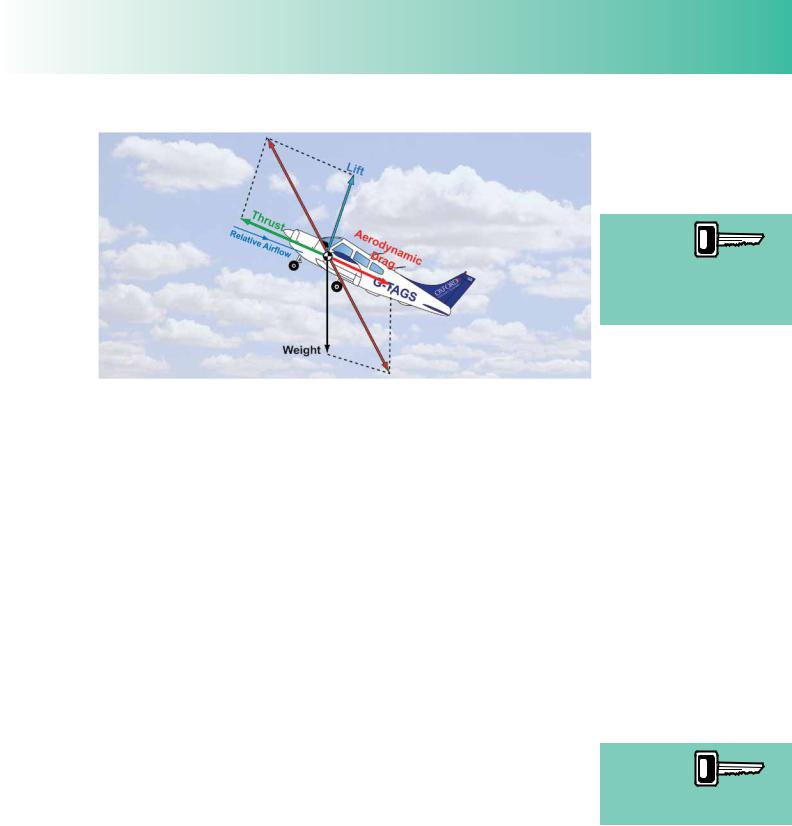
ID: 3658
Customer: Oleg Ostapenko E-mail: ostapenko2002@yahoo.com
Customer: Oleg Ostapenko E-mail: ostapenko2002@yahoo.com
CHAPTER 3: CLIMB
The lift
generated by an aircraft in a
steady climb,
at constant airspeed and power setting will be less than the aircraft’s weight.
Figure 3.6 Equilibrium in a steady climb, at constant speed. Total thrust is greater than aerodynamic drag, and lift is less than weight.
As the angle of climb steepens, the more the lift force reduces with respect to weight.
(For a Harrier jet fghter in a vertical climb, it is thrust alone which balances both the aircraft’s weight and aerodynamic drag, the lift force playing no role at all.)
Other Factors Affecting Angle of Climb.
Weight.
The greater an aircraft’s all–up weight, the greater the lift required to maintain level fight at any speed. The lift formula, Lift = CL ½ ρv2S, teaches us that for a given airspeed and at constant density, the increase in lift required to support a heavier aircraft can only be obtained by increasing CL. Unless fap is lowered, which may not be practical or safe, CL can be increased only by increasing angle of attack. An increase in angle of attack will increase induced drag, and so, at any given speed, more thrust is required to maintain level fight than for a lighter aircraft. Consequently, there will be less excess thrust available in level fight for the aircraft to climb. The angle of climb achievable at any speed will, thus, reduce. It follows that, when an aircraft is heavily loaded, the best angle of climb achievable will be less steep than the best angle of climb for a more lightly loaded aircraft.
For any given climb angle, an increase in weight will also increase the rearwards acting weight component (i.e. the weight apparent drag), requiring increased “excess” thrust to balance it. Therefore, for a given value of maximum excess thrust available from the propeller, which is already reduced for a heavier aircraft, the best climb angle achievable will be further reduced compared to a lighter aircraft.
Figure 3.7, overleaf, shows that the overall effect of increasing weight is that the thrust required curve moves up and to the right, whereas the thrust available curve remains unchanged. The graph confrms, then, that, at any given straight and level fight speed, the excess thrust available for the climb reduces, and that the best achievable angle of climb at that speed will be shallower than for a lighter aircraft. The graph for the heavier aircraft also shows that the speed at which maximum excess thrust is available, increases compared to a lighter aircraft.
Increasing
the aircraft’s all-up weight
will reduce the best angle of climb.
393
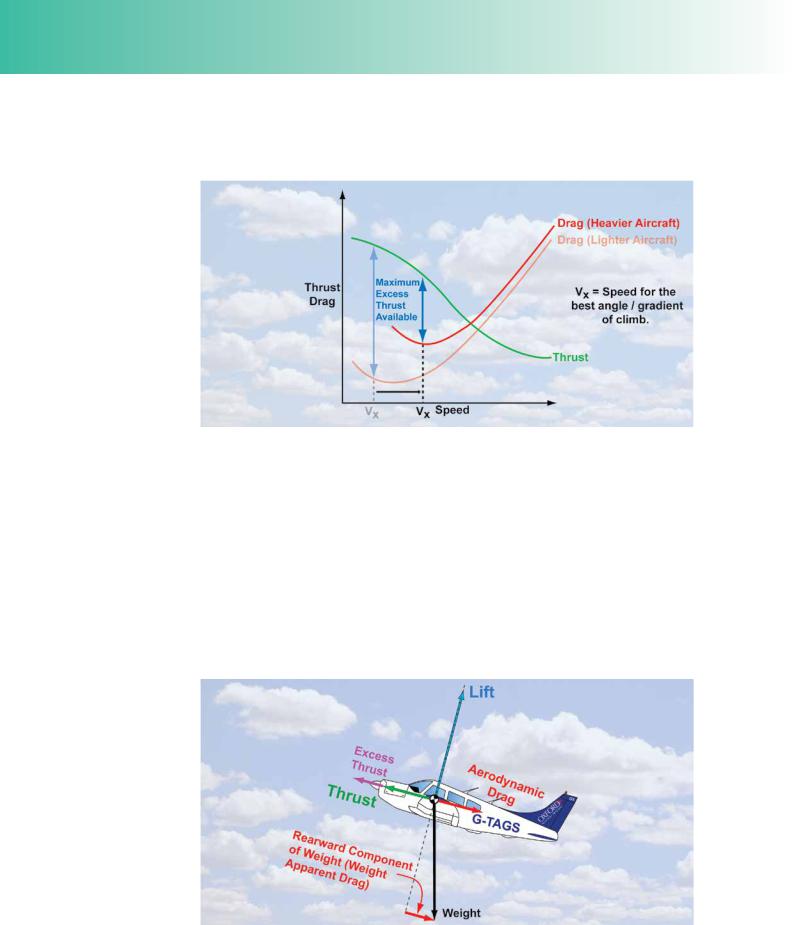
Order: 6026
Customer: Oleg Ostapenko E-mail: ostapenko2002@yahoo.com
Customer: Oleg Ostapenko E-mail: ostapenko2002@yahoo.com
CHAPTER 3: CLIMB
Consequently, the speed for the best angle of climb is higher for a heavy aircraft than for a lightly-loaded aircraft.
Figure 3.7 At increased aircraft weight, the thrust required curve moves up and to the right. The thrust available curve remains unchanged. For all speeds, excess thrust available for the climb reduces. Vx, the speed for the best angle of climb, increases.
To summarise, then, a heavier aircraft will have a shallower best angle of climb than a more lightly loaded aircraft, and the speed at which the reduced best angle of climb is achieved is higher.
Aircraft Configuration.
The angle of climb is also affected by the confguration of the aircraft. By confguration, we mean whether faps and undercarriage are extended or not.
Figure 3.8 shows a representative light aircraft in the climb, with faps and undercarriage retracted.
Figure 3.8 A aircraft in the climb, with undercarriage and faps retracted.
394
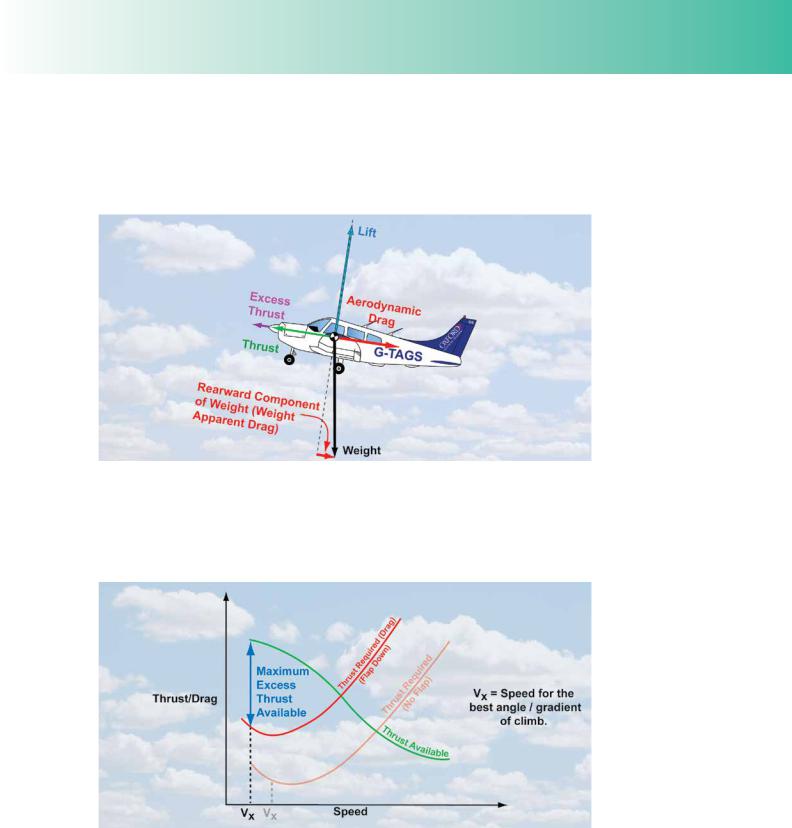
ID: 3658
Customer: Oleg Ostapenko E-mail: ostapenko2002@yahoo.com
Customer: Oleg Ostapenko E-mail: ostapenko2002@yahoo.com
CHAPTER 3: CLIMB
If the undercarriage and faps are extended, the parasite drag of the aircraft and, thus, its total drag, at any given speed will increase. Consequently, at any given speed, there is a reduction in excess thrust available from the propeller at that speed, and the best achievable angle of climb at that speed will also be reduced (See Figure 3.10.)
Figure 3.9 An aircraft in the climb with faps and undercarriage extended.
If we look again at the graph for thrust available against thrust required, for faps and undercarriage extended, we see that the thrust required curve which is based on the drag curve, has moved upwards, and to the left. The consequence of this change is although the excess thrust available has deceased, the speed at which maximum excess thrust is available for the climb, VX, has also decreased.
Figure 3.10 When parasite drag is increased, the thrust required curve moves upwards, best climb angle is reduced, and Vx is lower.
With the undercarriage and/or faps extended, VX is lower and the best achievable climb angle is shallower. A pilot might conclude, therefore, that, on take-off, it would be prudent not to lower faps, so that the climb angle is as steep as possible. However, faps do have a benefcial effect on take-off performance in the sense that they reduce the lift-off speed and the length of the take-off run. Consequently, faps
395
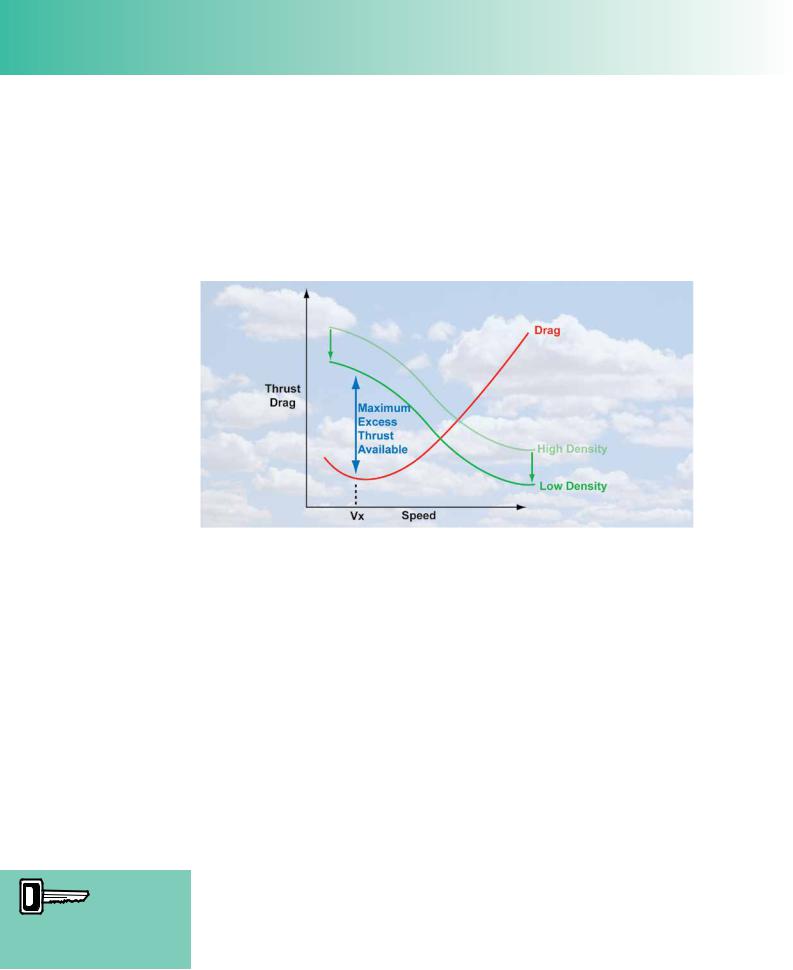
Order: 6026
Customer: Oleg Ostapenko E-mail: ostapenko2002@yahoo.com
Customer: Oleg Ostapenko E-mail: ostapenko2002@yahoo.com
CHAPTER 3: CLIMB
are often used for take-off, but are retracted in stages as soon as it is safe to do so, in order to increase the angle of climb as soon as possible.
The Pilot’s Operating Manual should be consulted for fap retraction speeds.
Density.
As you have already learnt in the chapter on Take-Off, both propeller thrust and engine power are affected by the density of the air in which an aircraft flies. A decrease in air density will reduce propeller thrust available.
A headwind increases the
angle of climb with respect
to the ground; a tailwind reduces it.
Figure 3.11 A decrease in air density will reduce propeller thrust, and reduce the excess thrust available..
From the graph, you can see that the decrease in air density, reduces excess thrust available, and results in the angle of climb being reduced at all airspeeds. You should note that indicated airspeed for the best achievable angle of climb will remain unchanged because indicated airspeed is a function of ½ ρv2, the dynamic pressure. The true airspeed, for VX however, will increase.
In order to take into consideration air density when calculating your aircraft’s performance, a pilot needs to know the aircraft’s density altitude. Density altitude is pressure altitude (i.e. vertical distance from the 1013.2 millibar (hectopascal) pressure datum line) corrected for air temperature. Calculations of density altitude are easy to perform using a standard fight navigation computer. (See Volume 3 of this series Navigation and Radio Aids.)
Normally, however, when using take-off performance graphs, air temperature and pressure altitude information is entered into the graphs separately. In this way, air density is taken into account.
Wind Speed and Direction.
Up until now in this Chapter, we have been considering angle of climb with respect to the air in which the aircraft is fying. But any aircraft’s angle of climb with respect to the ground is also affected by wind speed and direction, namely, the headwind and tailwind component. Climb angle with respect to the ground will steepen when fying into a headwind and be more shallow with tailwind. This topic has already been covered in Chapter 2: Take-Off. (See Figure 3.12.)
396
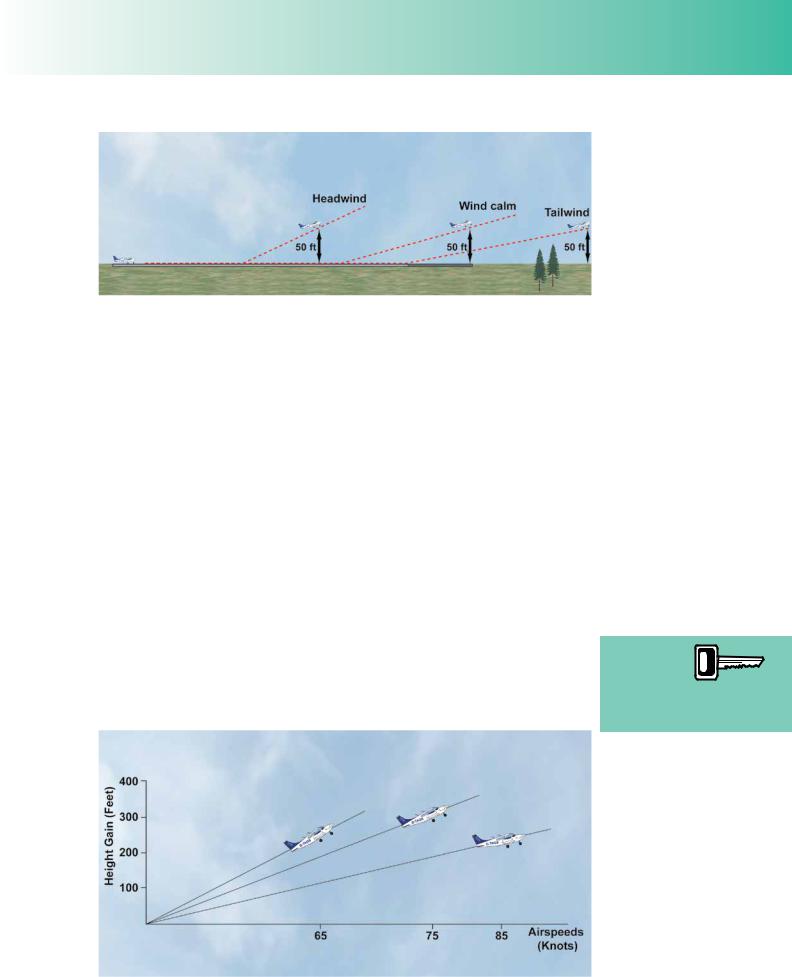
ID: 3658
Customer: Oleg Ostapenko E-mail: ostapenko2002@yahoo.com
Customer: Oleg Ostapenko E-mail: ostapenko2002@yahoo.com
CHAPTER 3: CLIMB
Figure 3.12 Relative to the ground, headwinds increase climb angle and tailwinds decrease climb angle.
RATE OF CLIMB.
Achieving the best possible angle of climb is of great importance when considering an aircraft’s obstacle clearance performance. But, often, following take-off, a pilot’s principal concern is to climb to the cruising altitude as rapidly as possible. If this is so, then the pilot is more concerned with achieving the best rate of climb, rather than the best angle of climb.
There is an important difference between rate of climb and angle of climb. The rate at which an aircraft gains height depends both on the angle of (or gradient) of its fight path and on its forward speed along that path. As you may imagine, an aircraft may climb slowly at a fairly steep angle or at high speed at a fairly shallow angle. For any given aircraft, however, there is one combination of speed and angle of climb, in other words of speed along a climbing fight path, which will permit the aircraft to increase its height by the greatest amount in a given amount of time. This will be the aircraft’s best rate of climb.
Figure 3.13 attempts to depict the concept of best rate of climb. The vertical axis represents gain of height in feet, and the horizontal axis represents airspeed. The speeds on the horizontal axis, below each aircraft, represent the airspeed at which that aircraft is fying. The aircraft on the middle sloping line, climbing at 75 knots, has made the greatest gain of height even though the aircraft on the left is climbing at a steeper angle, at a lower speed, and the aircraft on the right is climbing at a
The best rate
of climb will cause the
aircraft to gain
the most height possible in a given time.
Figure 3.13 Climb performance at different speeds.
397

Order: 6026
Customer: Oleg Ostapenko E-mail: ostapenko2002@yahoo.com
Customer: Oleg Ostapenko E-mail: ostapenko2002@yahoo.com
CHAPTER 3: CLIMB
higher airspeed, but at a shallower angle. The speed at which the middle aircraft is climbing represents the best rate of climb of speed. We can assume that all aircraft are climbing at full power, so the pitch attitude of the middle aircraft is the attitude which, at full power, gives the angle of attack required to attain the best rate of climb speed.
Rate of Climb is a Function of Excess Power Available.
We have learnt that angle of climb is a function of excess thrust. The diagram which illustrates the concept of angle of climb is a force diagram, which resolves forwards and rearwards acting forces. (See Figure 3.4.) However, rate of climb is a question of both thrust to achieve a given gradient of climb and speed along that gradient. Rate of climb, then, is a function of excess thrust multiplied by velocity. In other words, rate of climb is a function of excess horsepower. You may recall from your Physics lessons that power is the rate at which work is done.
Work
Time Taken
Power = Force x Distance
Time Taken
Power = Force x Speed
And, as force produced by a propeller is known as thrust,
Power = thrust x speed
To lift an aircraft weighing 2000lbs to 4000ft requires 2000 × 4000 = 8 000 000 ft-lbs of work. For a 2000lb aircraft to climb to 4000ft in 8 minutes would require work to be done at the rate of 1 000 000 foot-lb/min. Now 33 000 ft-lbs/min is defned as
One Horse Power; so the power required to lift a 2000lb aircraft to 4000ft in 8 mins is 1 000 000. 30.3 Horse Power, approximately.
33 000
To summarise, then, the aircraft’s maximum rate of climb is achieved at a gradient that is slightly less steep than that giving its maximum angle of climb, but at slightly higher airspeed.
As we have said, an aircraft’s maximum rate of climb is achieved at an airspeed in level fight, at which there is a maximum amount of excess thrust horsepower available for the climb.
Figure 3.14 is a representative graph of thrust horsepower available and thrust horsepower required to maintain level fight at any given true airspeed.
The maximum amount of excess power available for the climb occurs at the speed at which the distance between the two curves is the greatest. If we wish to calculate the achievable vertical speed of an aircraft, we may use the equation:
Vertical Speed (feet/min) |
= 33 000 x Excess Power Available |
|
Weight of aircraft |
398
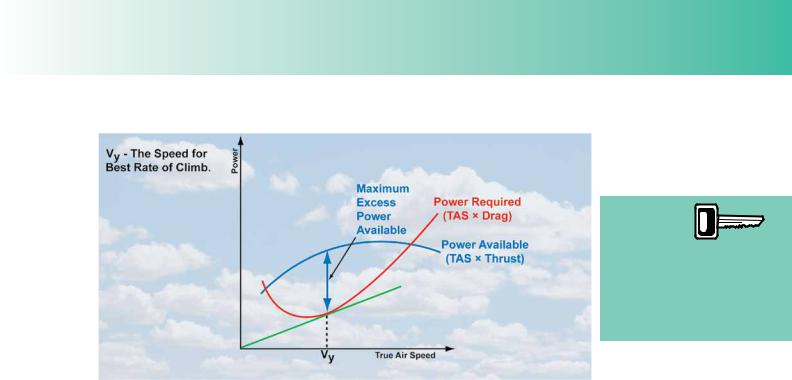
ID: 3658
Customer: Oleg Ostapenko E-mail: ostapenko2002@yahoo.com
Customer: Oleg Ostapenko E-mail: ostapenko2002@yahoo.com
CHAPTER 3: CLIMB
The speed
for maximum rate of climb
is the speed
at which there is the maximum excess of power available over power required for level fight at that speed. This speed is known as VY.
Figure 3.14 The speed for maximum rate of climb is the speed at which there is the maximum excess of power available over power required for level fight at that speed. This speed is known as VY.
For instance, in the case we have just considered of the aircraft weighing 2000lbs climbing to 4000ft in 8 minutes, which required an excess thrust horsepower of 30.3 HP, the equation may be written as:
Vertical Speed (ft/min) = |
33 000 x 30.3 |
|
2000 |
= |
500 ft/min |
Which is what we would expect as 4000 ft is reached in 8 minutes.
The Power Available and Power Required Curve.
The method of deriving the power available curve in the graph at Figure 3.14 requires a knowledge of power output of the internal combustion engine which goes beyond the scope of this book. The power available curve is basically an expression of power available after the power losses arising from the ineffciency of the propeller have been deducted from engine power output.
The power required curve is derived from the total drag curve for the aircraft. Total drag at any aircraft speed is multiplied by the speed itself to give the power required to overcome drag and to maintain level fight. You may ask yourself why the power required graph in Figure 3.14 indicates that high power must be delivered by the engine-propeller combination at low speeds as well as at high speeds. The explanation is that, at low speeds, the aircraft is fying at high angles of attack, resulting in high values of induced drag despite the low speed. At high speeds, angle of attack is small, but, of course, parasite drag is very high because airspeed is high and because parasite drag increases with the square of the airspeed.
When the power available curve is above the power required curve, level fight is possible, and, as we have seen, at the speed where the vertical distance between the two curves is the greatest, the rate of climb will be a maximum if full power is applied and a pitch attitude selected to maintain that speed.
The outside portions of the graph, beyond the two intersections of the power available and power required curves, indicate speeds at which level fight is impossible because,
399
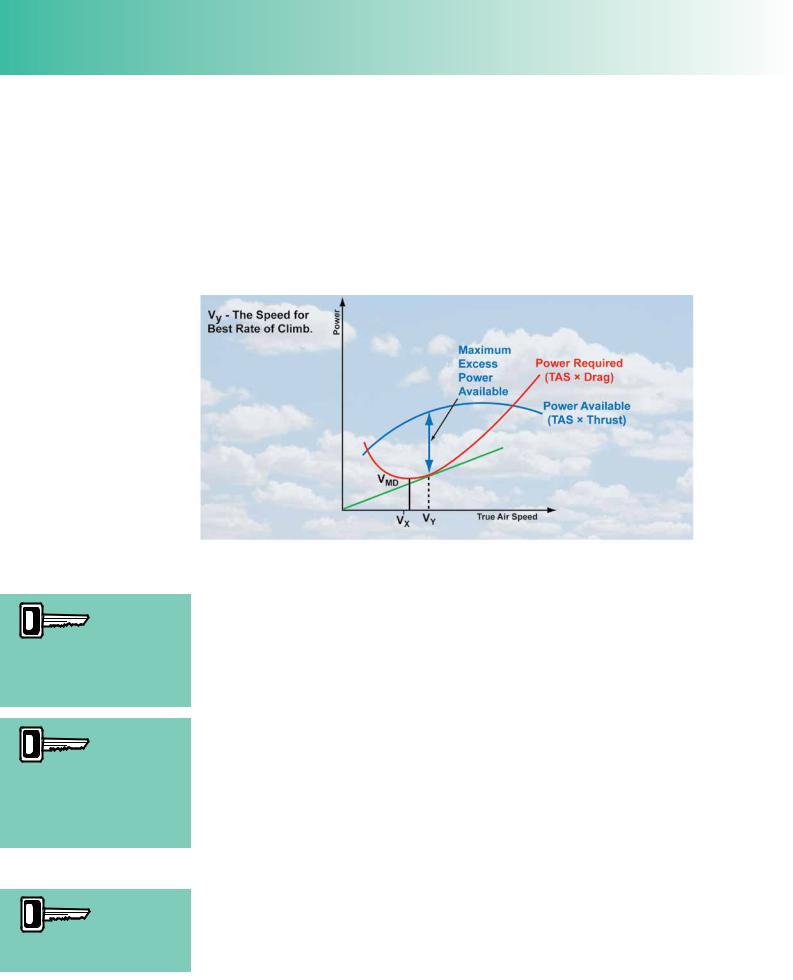
Order: 6026
Customer: Oleg Ostapenko E-mail: ostapenko2002@yahoo.com
Customer: Oleg Ostapenko E-mail: ostapenko2002@yahoo.com
CHAPTER 3: CLIMB
at those speeds, whether high or low, more power is required for level fight than the engine can deliver. The two intersections of the two power curves also reveal that full throttle is required to achieve not only the highest level fight speed attainable but also the lowest possible level fight speed.
The Speed for Maximum Rate of Climb.
The speed for maximum rate of climb is found by dropping a vertical line from the point at which a straight line drawn from the origin of the two axes touches the power required curve at a tangent. The speed for the best rate of climb is known as VY.
(See Figure 3.15).
VY is the speed at which
to fy to obtain the best rate
of climb. VY for the PA-28 Warrior, up to 5000 feet, is 75 knots indicated air speed.
The
manufacturer’s recommended best rate of
climb speed is often slightly higher than VY so that the airfow over the engine is suffcient for effective cooling.
The higher an aircraft’s
all-up weight (mass) the
lower the rate of climb.
Figure 3.15 The best rate of climb speed, VY, higher than both Vx and minimum drag speed,
VMD.
You should note that because thrust and power are not the same thing, the airspeed at which maximum excess thrust is available (VX) is not the same as the airspeed where maximum excess thrust horsepower is available (VY). Remember that thrust from a fxed-pitch propeller is maximum at full throttle with the aircraft stationary. By the time VMD is reached, propeller thrust will have begun to decrease, so maximum excess thrust available occurs at a lower airspeed than VMD. VX for the PA28-161 Warrior is 65 knots. VY for the PA28-161 Warrior is 75 knots. Since VY is a TAS, initial IAS should be reduced by 5 knots above 5 000 feet (see p51).
VY, then, is the speed to fy when seeking to achieve the maximum height gain in a given time. Nevertheless, some Pilot’s Operating Handbooks may give a speed slightly higher than VY as an aircraft’s best rate of climb speed because a slightly higher speed ensures a more satisfactory cooling effect on the engine at the high power settings and relatively low speeds used in the climb. If a pilot sees that cylinder head temperature and engine oil temperature are approaching their upper limits in the climb, he should increase speed.
Factors Affecting Rate of Climb.
Aircraft Weight.
As you have already learnt, the greater an aircraft’s all–up weight, the greater the lift required to maintain level fight at any speed. At a given speed, unless fap is lowered
(and we will assume here that it is not), lift can be increased only by increasing angle of attack. An increase in angle of attack will increase induced drag, and so, at any
400
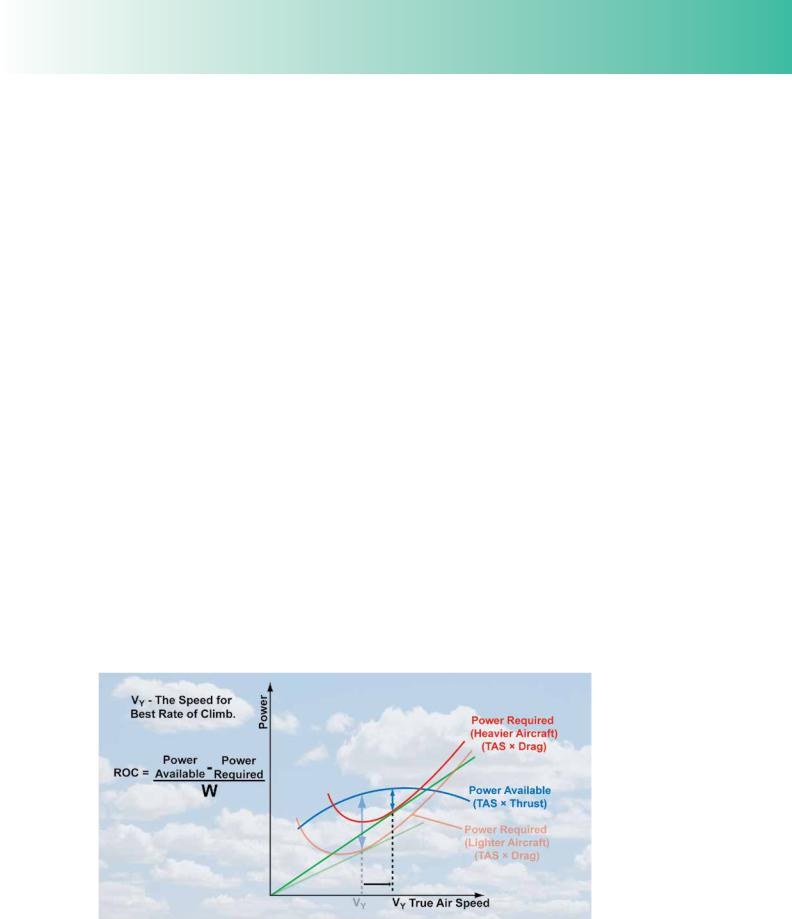
ID: 3658
Customer: Oleg Ostapenko E-mail: ostapenko2002@yahoo.com
Customer: Oleg Ostapenko E-mail: ostapenko2002@yahoo.com
CHAPTER 3: CLIMB
given speed, more thrust is required to maintain level fight than for a lighter aircraft.
If more thrust is required to maintain a given speed then more power is required, too, leaving less excess power available to achieve a desired rate of climb. This situation holds for all speeds; consequently, an increase in weight will cause a decrease in the maximum rate of climb. Conversely, a decrease in weight will improve rate of climb, at all speeds.
Also, as we have seen in the diagrams illustrating angle of climb, a climb at any angle with a heavier aircraft will lead to an increase in the weight component acting rearwards (the so-called weight-apparent drag). As the maximum rate of climb is achieved at a given combination of speed of climb and angle of climb, weight apparent drag will always be a factor. An increase in weight apparent drag leaves less power available for the climb, again decreasing rate of climb at all speeds.
The following equation for rate of climb that you met earlier in this chapter:
Rate of climb in feet per minute = 33000 x Excess Power Available
Weight
clearly shows that an increase in weight decreases rate of climb. The calculation that we made earlier to illustrate the use of this equation involved a 2000 lb aircraft with an excess of power available of 30.3 Horsepower, climbing 4000 feet in 8 minutes, at a rate of climb of 500 feet per minute. If we increased the aircraft’s weight to 2 300 lb. the equation shows us that rate of climb will decrease. Substituting the new figures into the equation, we obtain:
Rate of climb in feet per minute = 33000 x 30.3 = 435 feet per minute
2 300
At higher aircraft weights, then, the power required (drag x speed) for level flight is greater, for any airspeed. Minimum drag, and power required to balance that drag, is higher at the greater weight, and, in fact, as weight increases, the power required curve moves up as depicted in Figure 3.16.
Figure 3.16 An increase in weight moves the power required. Excess power available and rate of climb thus reduce at all speeds, but Vy is slightly increased.
401
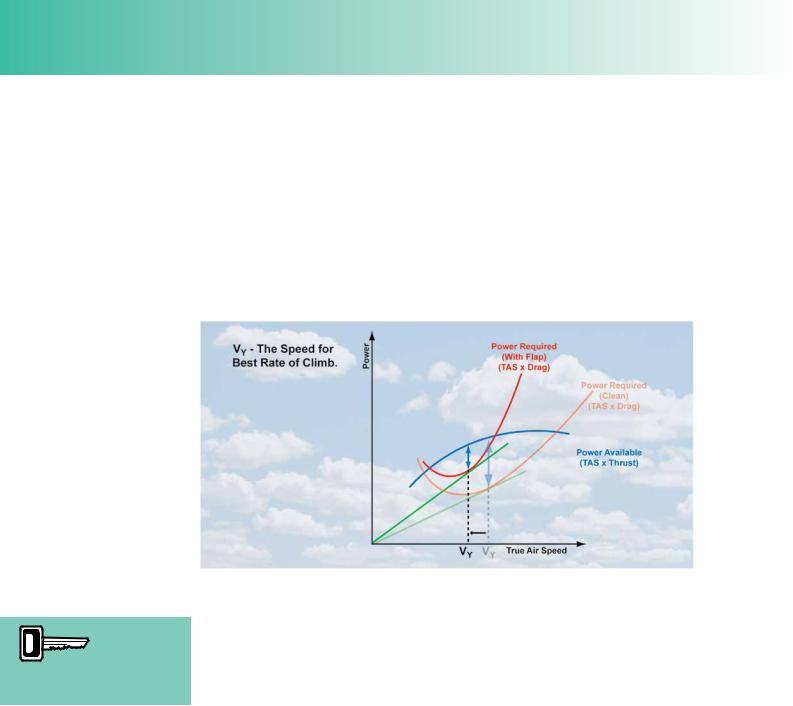
Order: 6026
Customer: Oleg Ostapenko E-mail: ostapenko2002@yahoo.com
Customer: Oleg Ostapenko E-mail: ostapenko2002@yahoo.com
CHAPTER 3: CLIMB
The graph for the higher weight illustrates clearly that there is less excess power available for the climb, at any speed; so the maximum rate of climb decreases and VY, the speed for the best achievable rate of climb at the higher weight, increases.
Aircraft Configuration.
Let us now consider the effect of flap on the rate of climb. We have already seen in our treatment of angle of climb, that use of flap increases drag at any speed and therefore will reduce the amount of excess thrust and excess power available for the climb at all speeds. Consequently, when faps are down, the power required curve, which as you have learnt is derived from the total drag curve, will move upwards and to the left. (See Figure 3.17.)
With fap
down, an aircraft’s rate of climb and
angle of climb will be reduced.
Figure 3.17 The extension of fap and/or undercarriage leads to an increase in parasite drag, causing the power required curve to move up and to the left.
The graph clearly illustrates that the maximum excess power available, and thus maximum achievable rate of climb, decreases with faps lowered. Furthermore, VY, the speed for the best achievable rate of climb is lower than for a clean aircraft.
Altitude and Atmospheric Density.
With increasing altitude, air density decreases.
The effect of reduced air density is to increase the power required for level fight, at any given airspeed, but decrease the power available.
So, reducing air density will cause the power required and power available curves to close up, as shown in Figure 3.18, opposite.
Figure 3.18 shows clearly that, with decreasing air density, the excess power available for the climb is reduced, at all speeds. We can deduce, then, that reduced air density (increasing altitude) will cause the maximum rate of climb to decrease. If an aircraft’s engine is ftted with a turbo-charger, the decrease in climb performance with altitude can be delayed, but most light training aircraft are not turbo-charged.
You can also see from the graph that speed for the best achievable rate of climb is higher at the lower density. However, it is important to grasp that the speeds used
402
